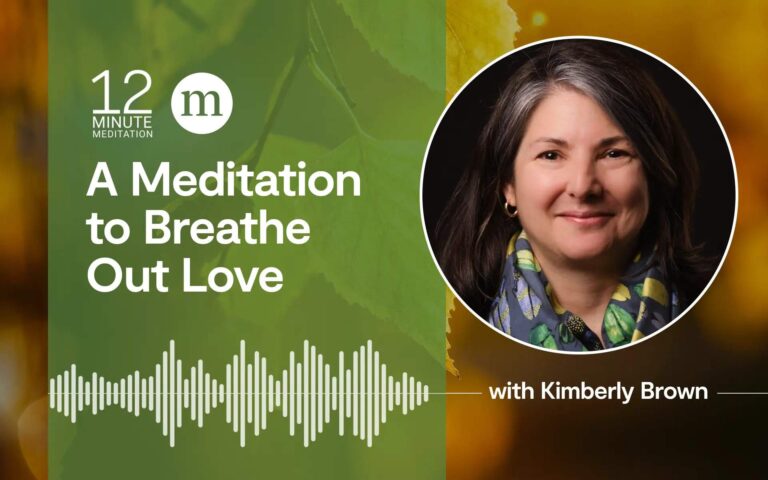“`html
This week, meditation instructor Kimberly Brown presents a calming loving-kindness meditation aimed at acknowledging challenges and fostering love.
Tonglen, often referred to as loving-kindness meditation, is a Tibetan practice centered on the concepts of giving and receiving.
In Tonglen, we become open to our full range of experiences, including moments of pain and difficulty. We recognize our own suffering and the suffering shared with others. Subsequently, we send out intentions for peace, healing, and love into the universe.
Today, Kimberly Brown leads us through a gentle meditation inspired by Tonglen. This practice allows us to acknowledge our struggles, breathe in any tension, and breathe out love, fostering a sense of ease and harmony with ourselves and others.
Please be aware that this practice includes extended periods of silence for deep reflection. If you prefer more time, you can pause the recording at any point.
A Meditation to Breathe Out Love
Follow the guided meditation script below, pausing after each section, or listen to the audio version.
Remember, this practice includes long silences to give you time for contemplation. Feel free to pause the recording whenever you need more time.
- If you’re familiar with Tonglen, it may have been taught to you as a visualization. Typically, it’s guided that as you inhale, you can visualize breathing in darkness or smoke during times of struggle. When you exhale, imagine releasing light or fresh air. In today’s session, we won’t focus on visualization, but you’re free to use that technique if it helps you connect.
- To start, get comfortable and still. Find a quiet space where you can relax without interruptions for about 10 to 15 minutes. Since you are using a device to listen, gently move it away from you. Avoid checking emails or listening to music right now. Use this time to get quiet and pay attention to yourself with kindness.
- You can either lie down, sit, or even walk or stand. Begin to observe what you feel in this moment. Notice light entering through your eyes, smells reaching your nose, sounds entering your ears, and tastes on your mouth. Pay attention to all the sensations in your body, the weight of it, and the feel of the air on your skin. Acknowledge your breath and allow yourself to experience it.
- Remember, you don’t need to do anything. Simply accept your breath, allowing your body to breathe freely. You’re also receiving light through your eyelids or your eyes, sounds through your ears, and information through your thoughts. There’s no need to push anything aside or create anything new; just let everything arrive and depart naturally.
- For the next few minutes, there’s nothing to fix or resolve. Just let all these sensations come to you and observe how they appear and disappear. If you find yourself caught up in a long thought, that’s fine. Gently return to your breath as a way to reconnect, then relax and open yourself once more for a couple of minutes.
- After the pause, check where your focus is. For instance, notice light coming into your eyes, thoughts passing through your mind, scents filling your nose, and your breath flowing in and out. Take a moment to acknowledge your intention for today’s meditation. You could be doing a multitude of other activities, yet you chose this time for compassion and mindfulness. Appreciate your intention and thank yourself for making this effort.
- Now, focus on your breath. Place a hand on your heart and another on your stomach, and observe your breathing: the expansion in your chest and belly as you inhale, and the contraction as you exhale. Feel your presence. As you breathe in, gently allow yourself to acknowledge any areas of tightness or stress.
- Recognize any painful emotions or thoughts. Draw them closer, breathing them in. When you exhale, let go of that tension. Relax and give yourself a sense of ease. Embrace space and comfort. Continue to breathe in your difficulties as if you were hugging someone in distress. With each exhale, offer yourself peace, ease, and reassurance, reminding yourself that everything is okay. Keep this rhythm of breathing in your struggles and breathing out kindness and patience for a few minutes.
- After the silence, check your focus again. If you find the need to start anew, that’s alright. Gently reconnect with yourself. Inhale your issues and exhale a sigh of relief, allowing for one more minute of openness.
- Following this pause, consider that whatever difficulty you face, many others are experiencing similar struggles. Whether it’s an illness, financial trouble, or conflict with loved ones, recognize that others share these experiences. Think of all the people dealing with similar circumstances. For instance, after losing my father a few years ago, I consider everyone who has lost their fathers as well. Breathe in the shared challenges and difficulties, and then breathe out a sense of relaxation, patience, and comfort for both yourself and those others in hardship.
- Continue this process as long as you wish. If you desire more silence, just pause the recording. Keep the cycle of inhaling difficulties and exhaling love going for as long as you need.
- When you feel ready, you can release the technique and allow yourself to simply relax. Thank yourself for your practice today. I appreciate your willingness to participate and for your caring heart. Feel free to reach out with any questions or comments. Thank you.
“`


